Capital:
Addis Abeba
Currency
Birr
Best time to visit:
The best climate is in January and February, a period of dry heat. Equally pleasant, but cooler are the months from June to September. The rains are particularly intense from March to May and less abundant from October to December.
In a word:
Milikami idili (good morning)
Vaccines
Malaria is widespread; antimalarial prophylaxis is recommended in areas below 1500 meters above sea level and in particular in the Omo Valley.
Warnings:
– The stop in Addis Ababa is often unavoidable but there are some neighborhoods that are better avoided.
– There are areas of the country that are unsafe, especially in the North. Follow the travel advice of the Ministry of Foreign Affairs.
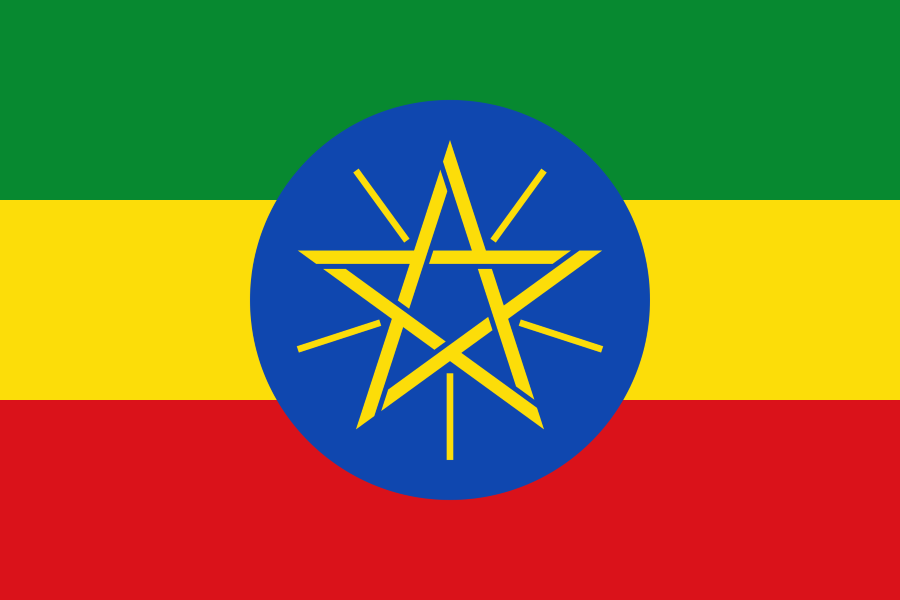
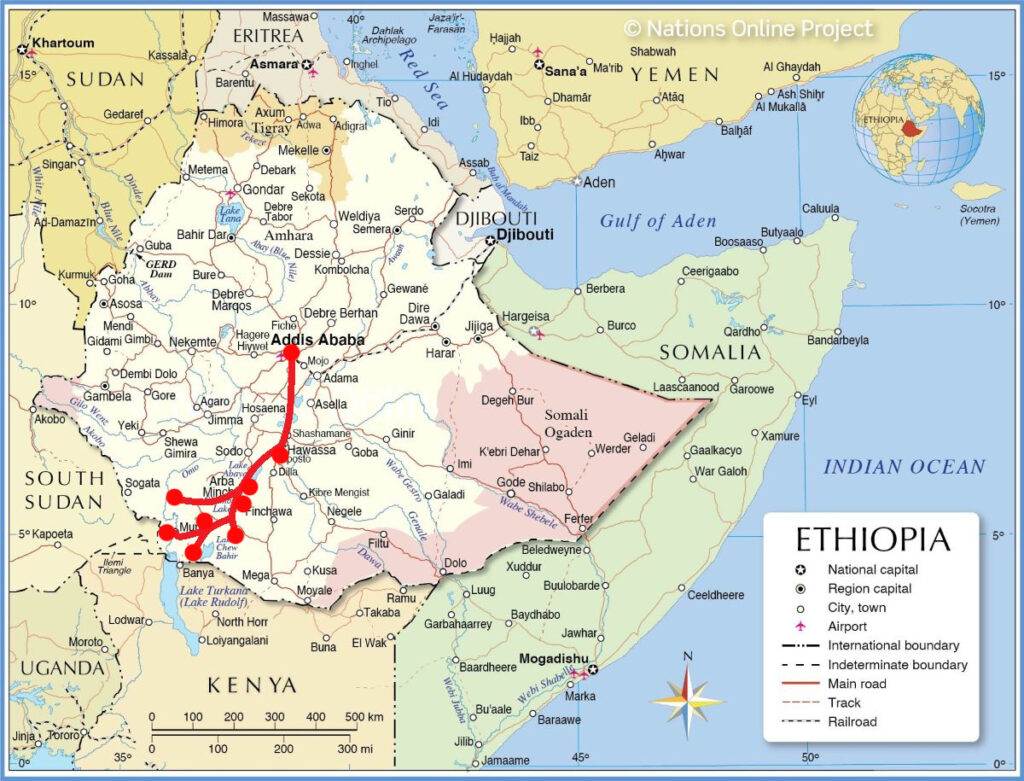
Essential experiences: Get lost among the enchanting tribes of the Omo Valley without prejudice; Sailing on the waters of Lake Chamo to discover the ferocious crocodiles; Enjoy the famous Ethiopian coffee by witnessing the entire preparation ceremony.
We leave with a van from the capital Addis Ababa to discover the south of the country, heading towards the Omo Valley which remains one of the wildest regions in Africa; you are immediately fascinated by the beauty of the Mursi, the Karo, the Banna, the Hamer. Feathers, shells, flowers, fruits, foliage are transformed into hairstyles, hairstyles and other ornamental jewels in their hands. Necklaces of butterfly wings, shell belts and feather chignons reflect the harmony that binds these peoples to nature whose prodigality and beauty they reveal; it is a journey of infinite emotions and truly interesting from an anthropological and naturalistic point of view; having lived until now these ethnic groups in a situation of partial isolation, they have managed to preserve very strong traditions and lifestyles; body decoration, scarifications and jewels constitute distinctive tribal signs but, as already mentioned, they are also artistic expressions; particularly impressive are the lip plates used by Mursi women, the enormous necklaces worn around the neck with great pride by Nyangatom women are wonderful; often their primitive customs which, to us Westerners, may appear incomprehensible and repugnant, are aimed at achieving an objective tenaciously pursued by all the peoples of the earth: pleasing themselves and others, for which we have no right to judge anything! In addition to the various ethnic groups, this journey also offers the opportunity to admire beautiful landscapes, we move from areas with dense vegetation to areas of scrubland and savannahs with the richest fauna in Ethiopia.
Our suggested itinerary (14 days) | |
two days: | Addis Ababa (city tour, View Point Entoto, Merkato) |
four days: | Arba Minch (Dorze tribe meeting); Konso (Konso tribe meeting); Jinka (visit local market; meeting Mursi tribe and Ari tribe); visit Omo Child Orphanage |
four days: | Turmi (Banna tribe meeting; Hamer tribe; Nyangatom tribe); Korcho (Karo tribe meeting); Dimaka (Bull Leaping) |
four days: | Omorate (meeting Dassanech tribe and Arobore tribe); Lake Chamo (boat excursion to discover Nile crocodiles); Lake Hawassa (fish market and visit to Gudumale Park); Addis Ababa |
The Omo Valley is not only the most fascinating mosaic in Ethiopia but the fulcrum of an entire continent.
Let's start this adventure from Addis Ababa, its imposing capital. The fourth African metropolis, it is a place of strong contrasts where different realities coexist: the shepherd who brings his flock to the market from the countryside, the city priest who takes care of the church, the glittering nightclubs, the merchants who transport anything and everything on the boss…
The day begins with the beautiful visit from the viewpoint of Mount Entoto (3200 m)... we travel with Bereket (Becky) and her team fromOmo Valley Origin Tours.
Addis Ababa seen from above appears like an infinite blanket of houses, buildings and slums as far as the eye can see, more than 10 million people live here.
Here we taste the first famous coffee!
Legend has it that, hundreds of years ago, a shepherd named Kaldi noticed that his goats became strangely agitated when they grazed on the berries of a certain plant. The shepherd then decided to taste it himself: he chewed the berries for a while and swallowed some, feeling a pleasant sense of excitement.
he told this adventure to the local monks who scolded him for having tasted the "devil fruit" and threw the berries into the fire. The aroma that was released immediately changed the monks' minds!
Then they began to dry the fruits of the plant and sell them in the various Ethiopian monasteries. Here the priests rehydrated the grains in water, ate the fruits and drank the liquid obtained to keep them awake during night prayers.
The Arabs began to import coffee, the Turks perfected roasting techniques and from Turkey it expanded throughout Europe: here is coffee.
We spend most of the afternoon in one of the largest and most beautiful markets we have ever seen.
Breaking through the chaos of the “Market” is a real feat. You could be inebriated by the scent of incense but also discover that your wallet has been robbed!
According to some, it is the largest market in Africa but since its exact borders are as obscure as some of its characters, this figure is difficult to verify.
Before retiring we stop at the Ethnographic Museum of Addis Ababa where we retrace some of the history of this country, also focusing on the strange period of the Italian occupation.
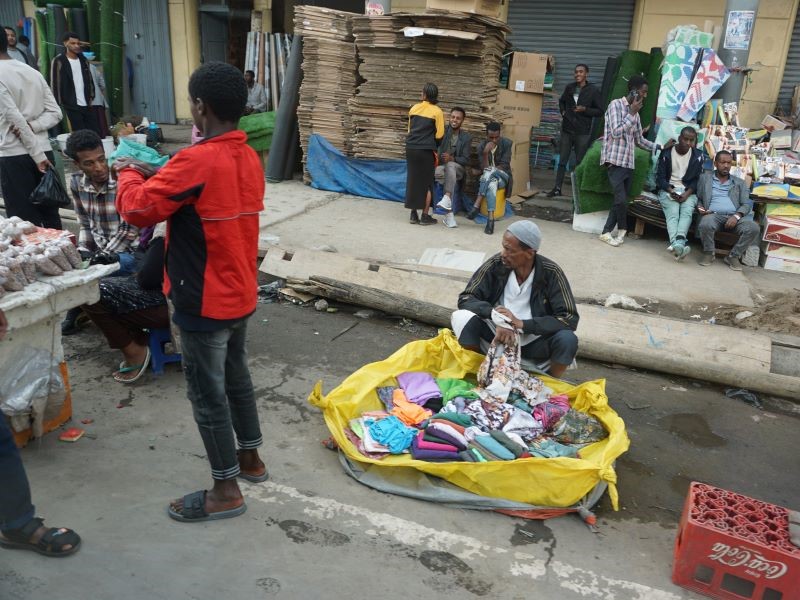
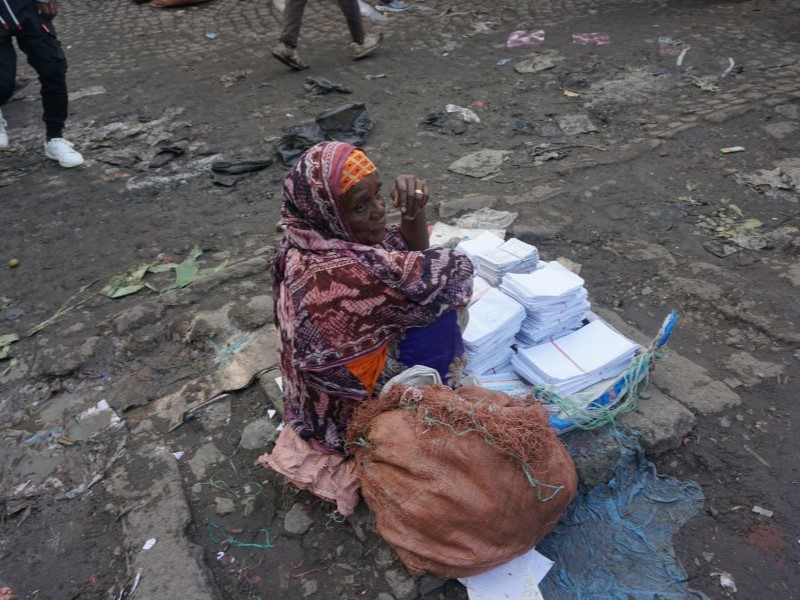
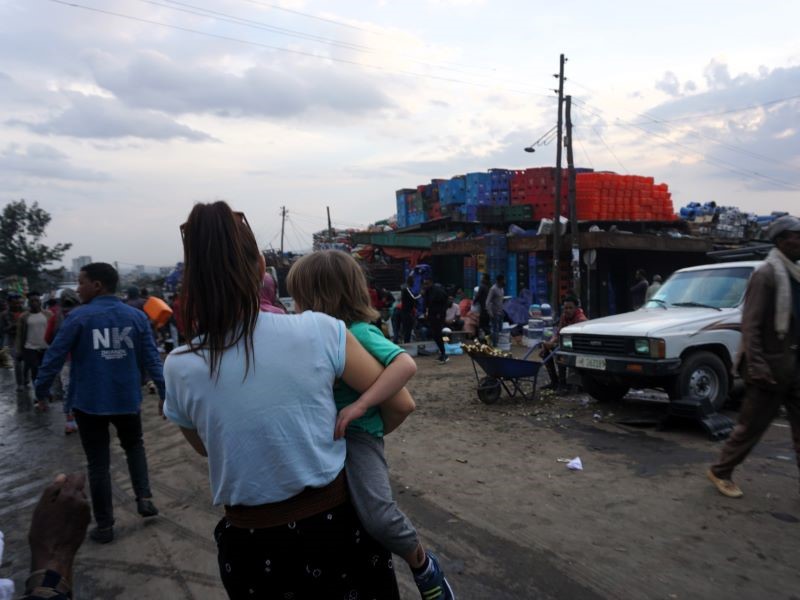
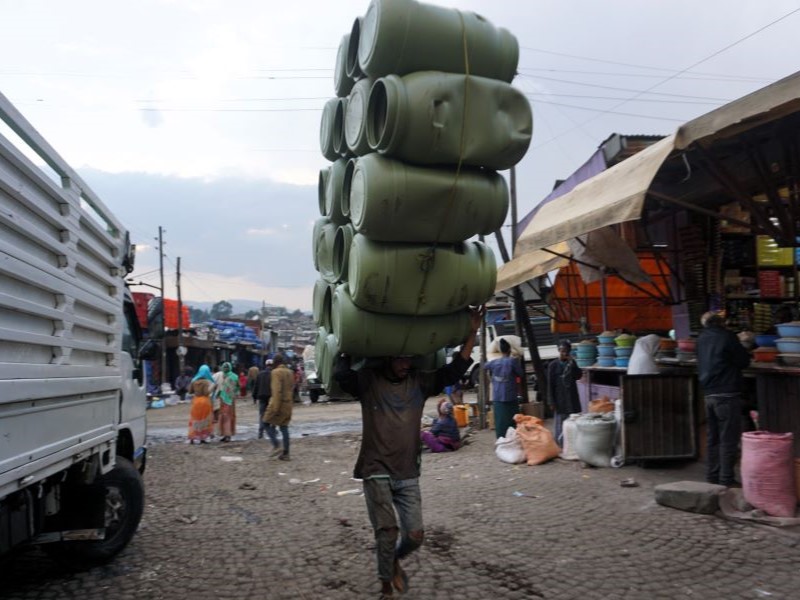
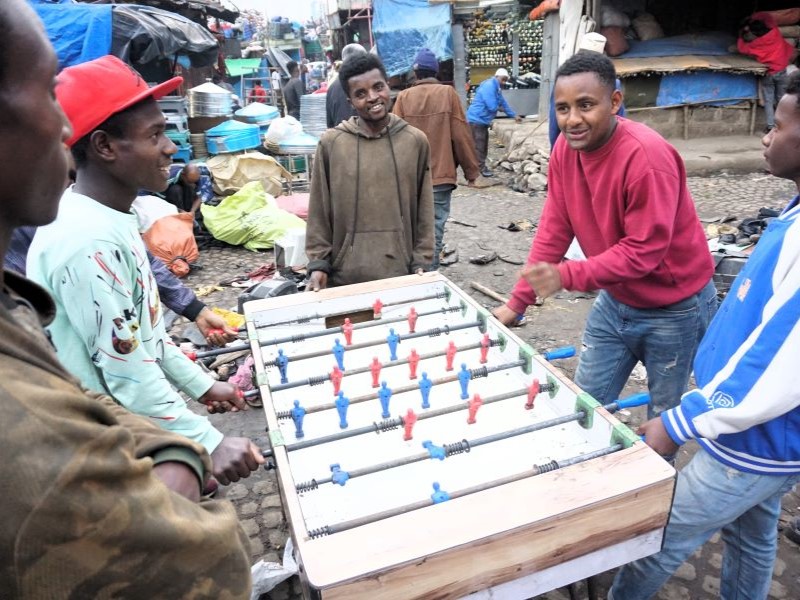
We stay at the Monarch Park View Hotel, very nice hotel, well located and with a truly wonderful roof restaurant with a beautiful view of the city.
Long day of transfer to Arba Minch.
We stop for a fleeting lunch on the shores of Lake Hawassa before reaching Dorze.
This ethnic group is famous for its tall huts and refined cotton fabrics. Up to 12 meters high, the Dorze huts resemble large elephant heads with eyes that serve as chimneys.
these huts can last up to 90 years, the smoke from the central fire helps keep them dry, also keeping termites away even if they eat the house from the base.
Interesting is the long process that takes the enset (false banana) from its harvest to the three-month fermentation underground until it is cooked on a kind of pan which transforms it into a kind of piadina.
We set off again and in the evening we reach Arba Minch. We are very tired and are staying at the Mora Heights Hotel, a hotel with very basic rooms but with a beautiful view of the Rift Valley.
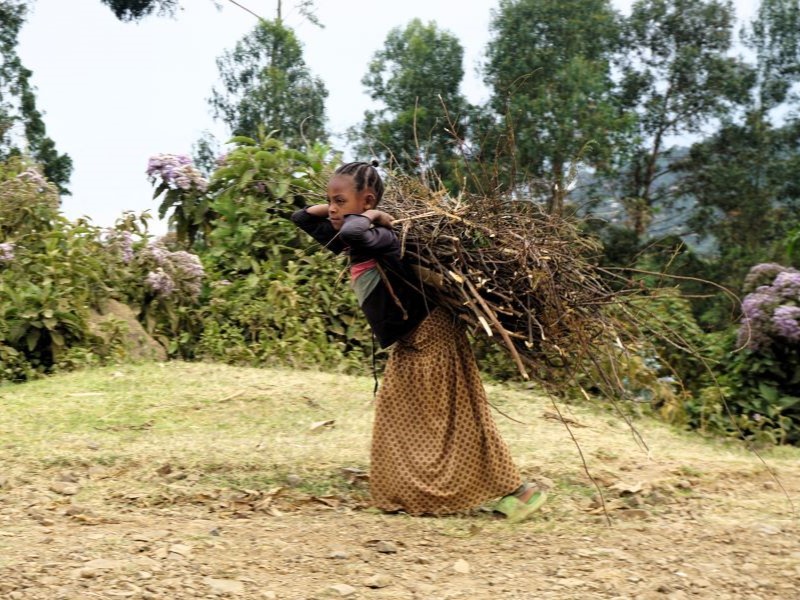
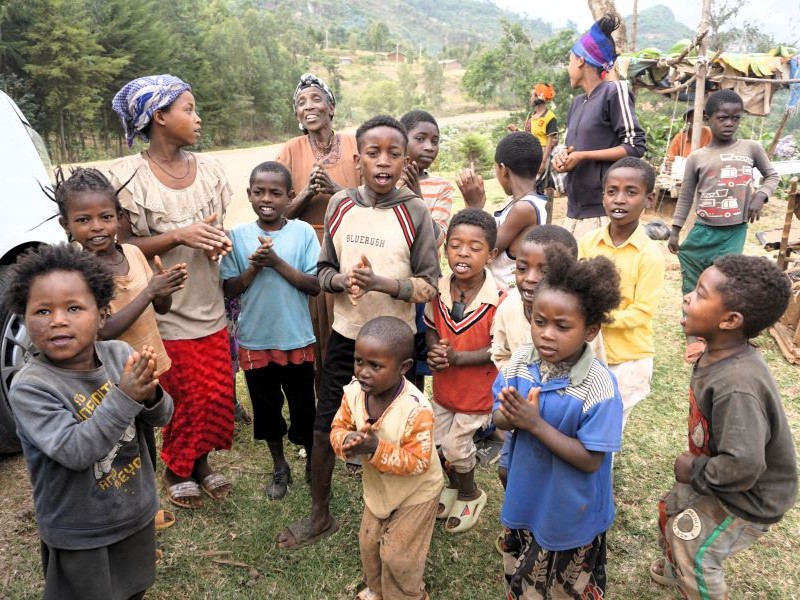
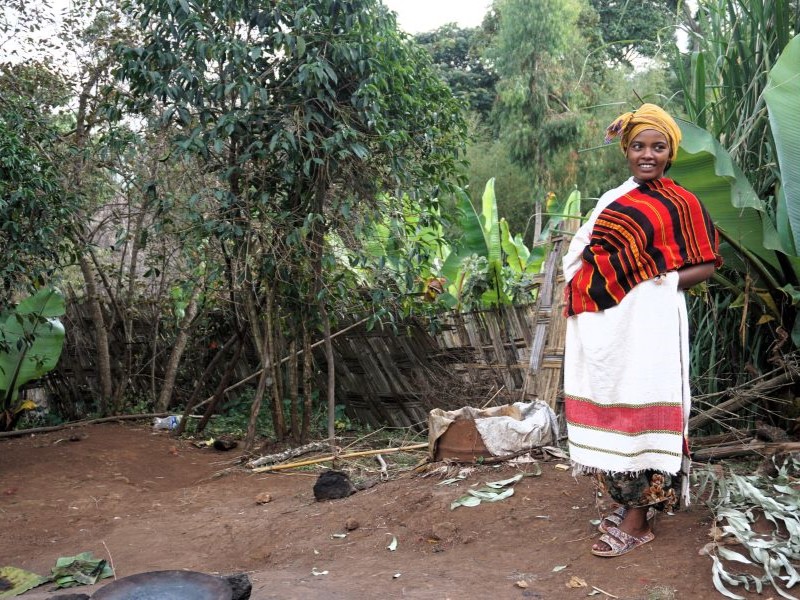
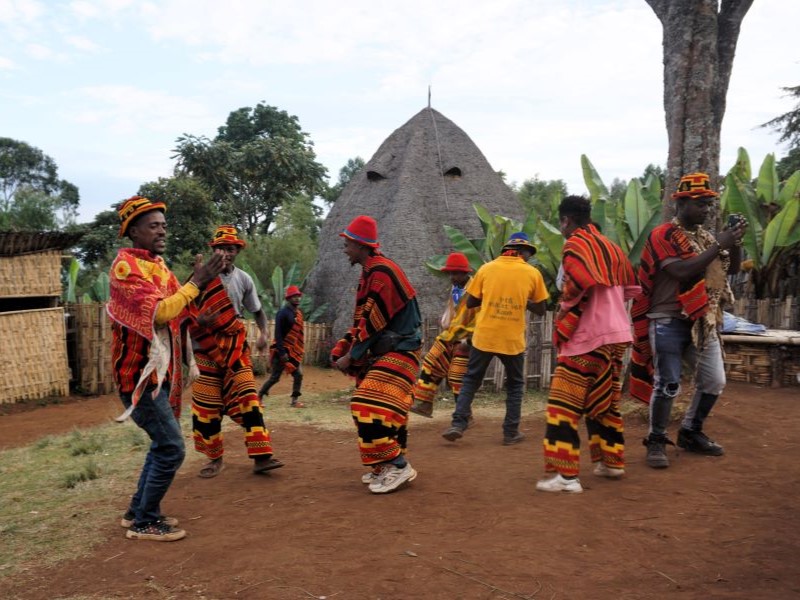
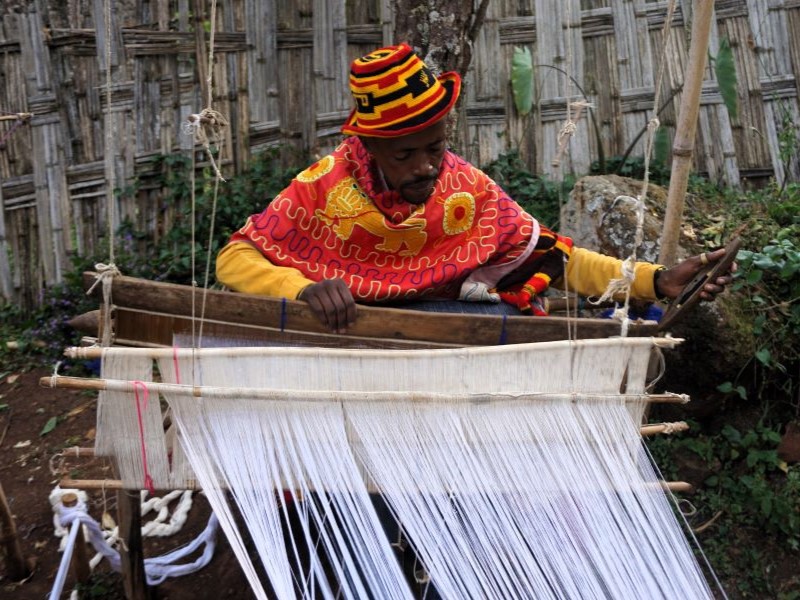
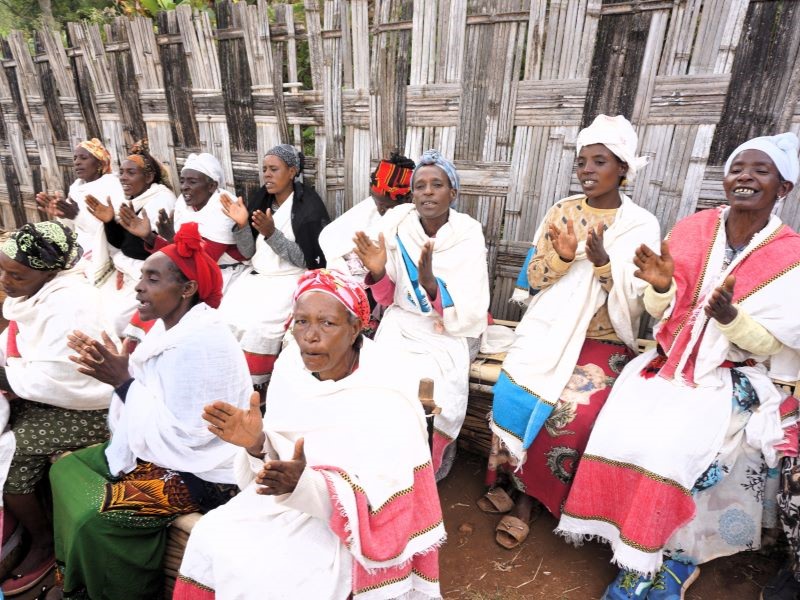
The stone walls, terraced fields and ceremonial structures are an expression of a unique lifestyle, so much so that this area has been declared a World Heritage Site.
We are greeted by the “waga”, a series of carved wooden totems erected in honor of the Konso warriors after their death and depict the warrior, his enemies and the dangerous animals he killed.
Very characteristic are the great walls erected in ancient times to defend oneself from one's enemies or from ferocious beasts, hyenas in particular. It is very nice to listen to the stories of ancient traditions relating to the tests that boys must pass in order to get married (carrying a large spherical stone behind their head) or the village calendar which indicates, based on the knots in the ropes, the age of the village.
In the late afternoon we arrive in Jinka, we sleep at the very decent Nasa Pension and, as the sun sets, we find ourselves immersed in the magnificent local market totally enraptured by the daily life of this town in the Omo Valley.
About 50 km from Jinka, two hours of dirt road through Mago NP, we meet the wonderful Mursi tribe.
The approximately 7,500 Mursi are predominantly shepherds. Traditionally they move during the rainy season and practice agriculture by exploiting the land made fertile by the flooding of the Omo River.
Among the best-known traditions of this people are the ferocious fights with the sticks of the men and the lip discs carried by the women. These clay discs, which measure up to 12 cm in diameter, are inserted into an incision made in the lower lip. The cut is performed around 15 years of age and kept under tension for several months. At this point, women have their four lower incisors extracted, while men only have two.
The origin of this custom is not known, it is hypothesized that it was born in the times of slavery when people became ugly so as not to be caught by slavers who were looking for the most beautiful and strongest people.
Over time it seems to have become an aesthetic practice that marks the entry into adulthood. Large ear piercings in women are pierced around the age of 5.
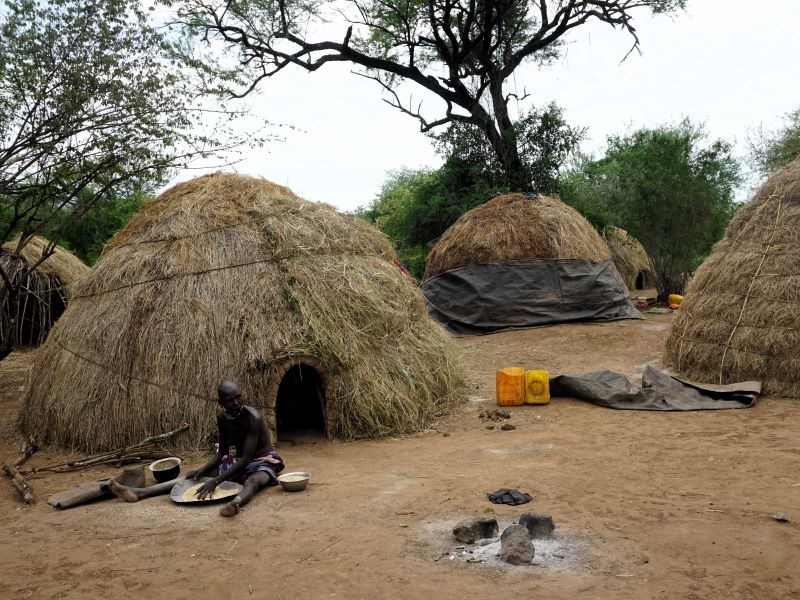
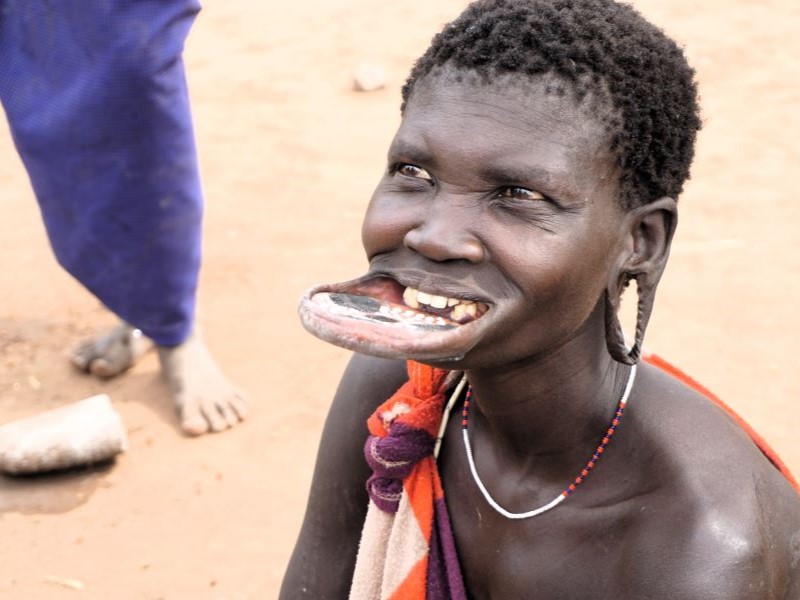
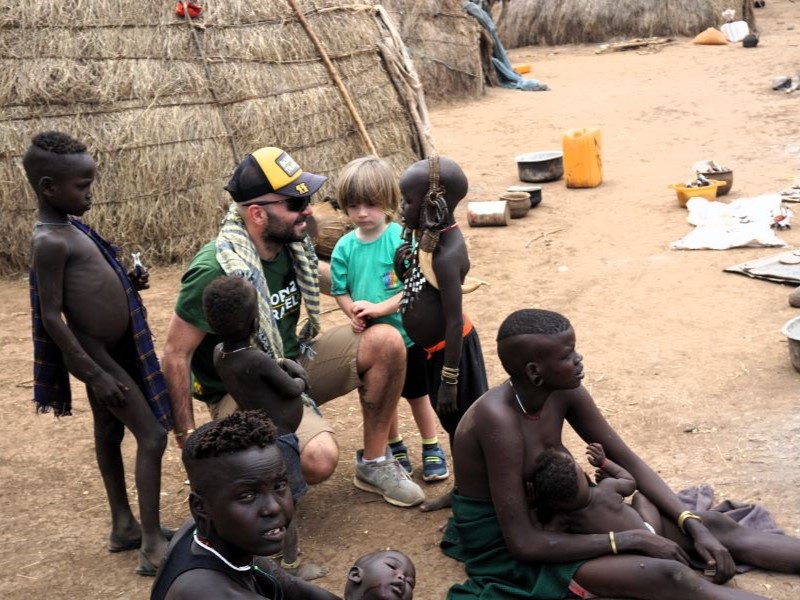
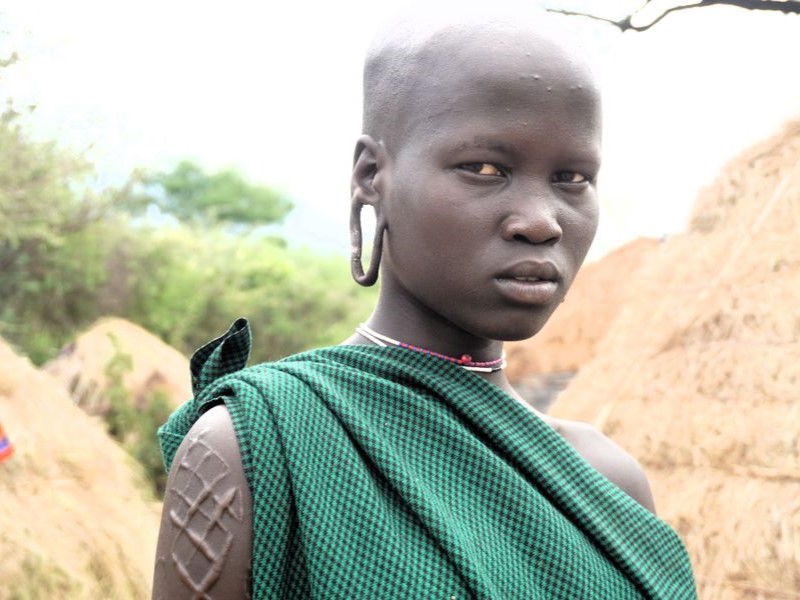
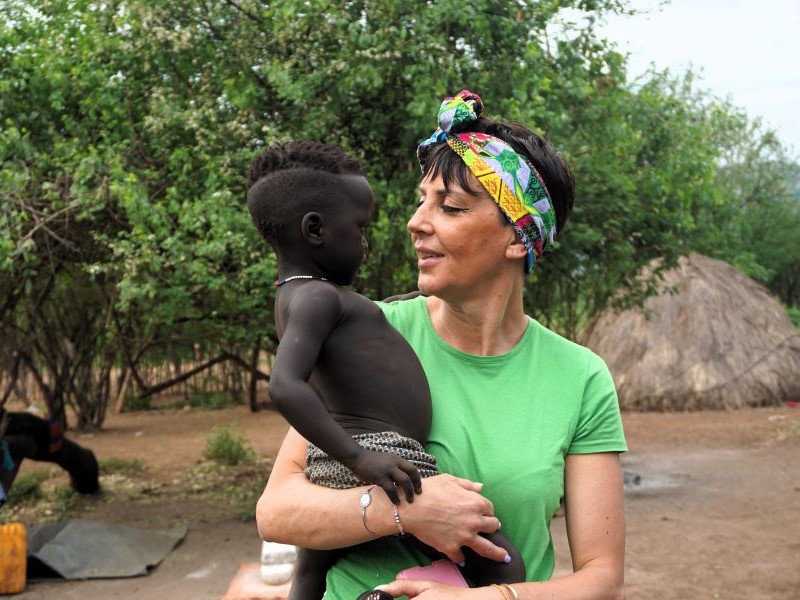
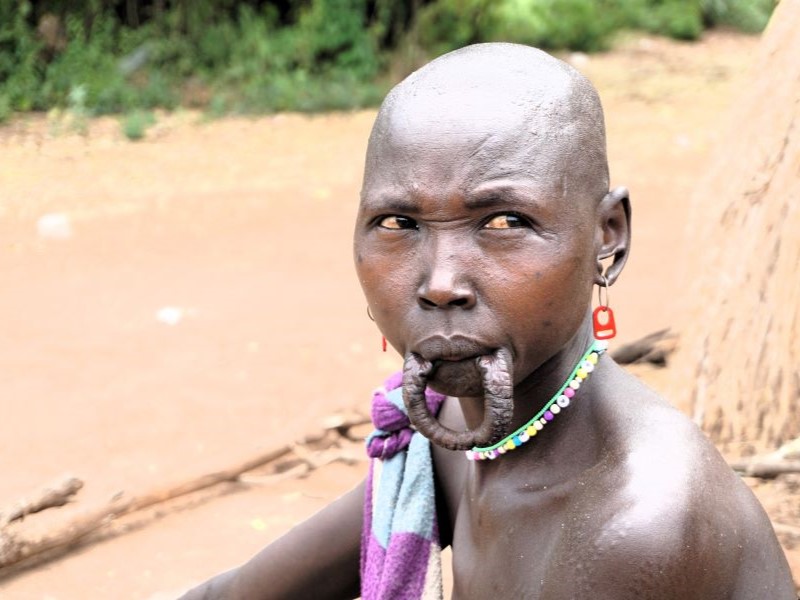
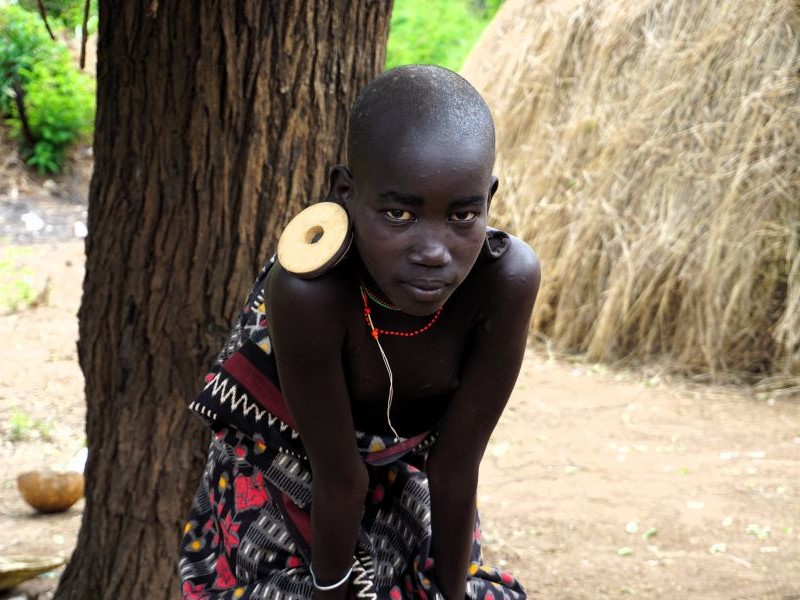
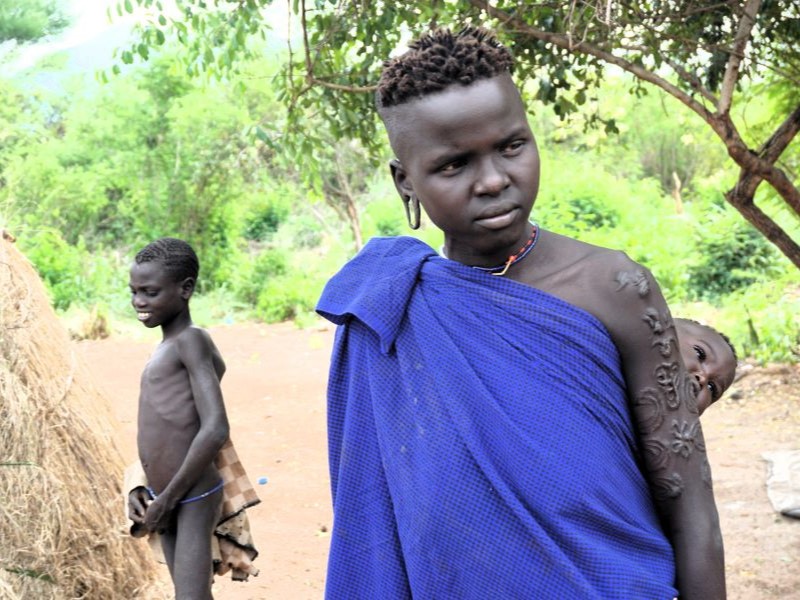
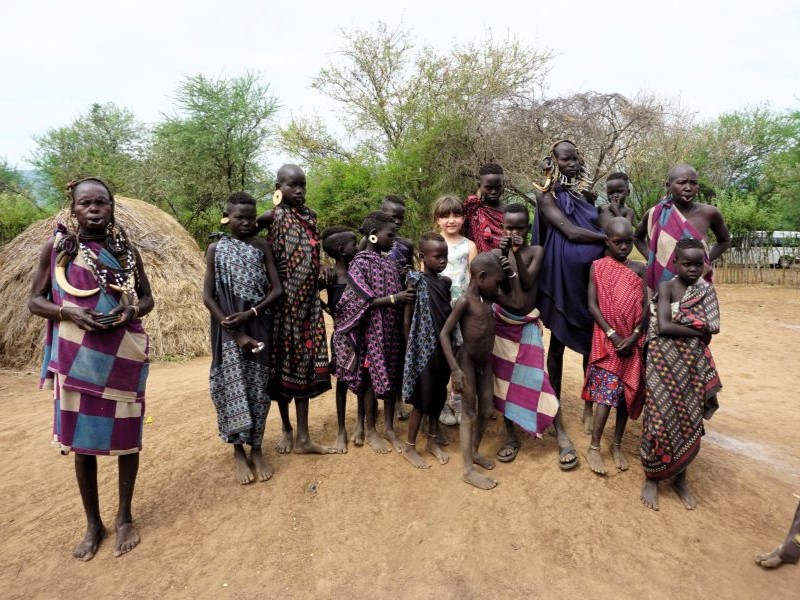
After a quick tour of the colorful Jinka fruit market, very picturesque and real, we reach the small village inhabited by the Ari tribe.
This is by far the largest tribe in the Southern Omo, approximately 290,000 people. Most are farmers (they grow sorghum and coffee) but livestock farming remains an important activity and all villages have blacksmiths and potters.
It was very instructive and interesting to see these craftsmen at work using simple, almost medieval I would say, methods. They also produce large quantities of honey from hives made from bark and dung and often sell it as well.
In the evening we are guests of Bereket for dinner at mother's house who prepares us an excellent tray with chicken, eggs, spicy sauce on a large injera and to finish a delicious Ethiopian coffee following the whole traditional ceremony!
The electricity goes out, as often happens here, and we will find it again only 4 days later... no problem, by candlelight it is even more characteristic!
Before leaving we pay a visit toOmo Child. An association that deals with the rescue of the so-called "cursed children".
Lale, its founder, is trying with many sacrifices to save these children destined to die just because they have some small physical deformity or are children born out of marriages or unions not blessed by their parents. These poor souls were destined to be abandoned in the jungle or drowned in the river. He, against everything and everyone, asked the community to allow him to be the river and the "bush" for these children. Otherwise they would have been killed because they were cursed and because they would have brought curse, problems and famine to their village.
The visit was very exciting and we took the opportunity to leave our small contribution to this cause!
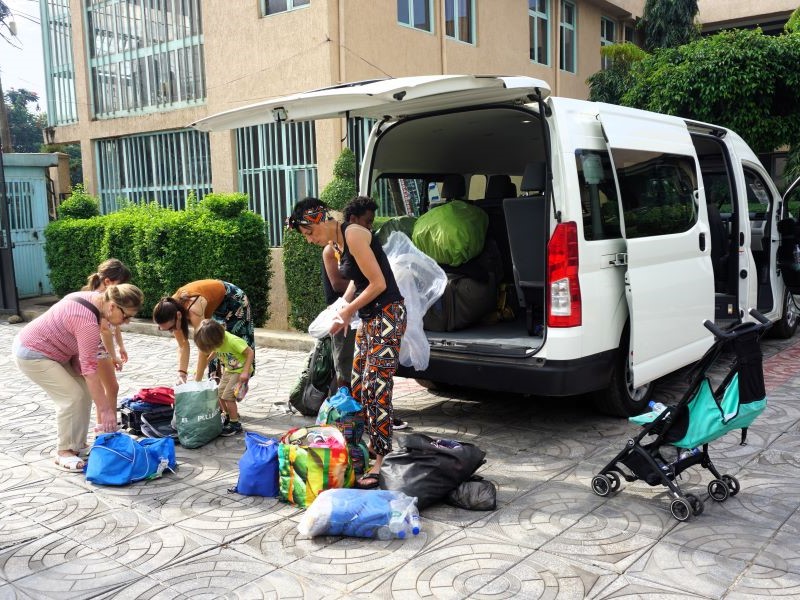
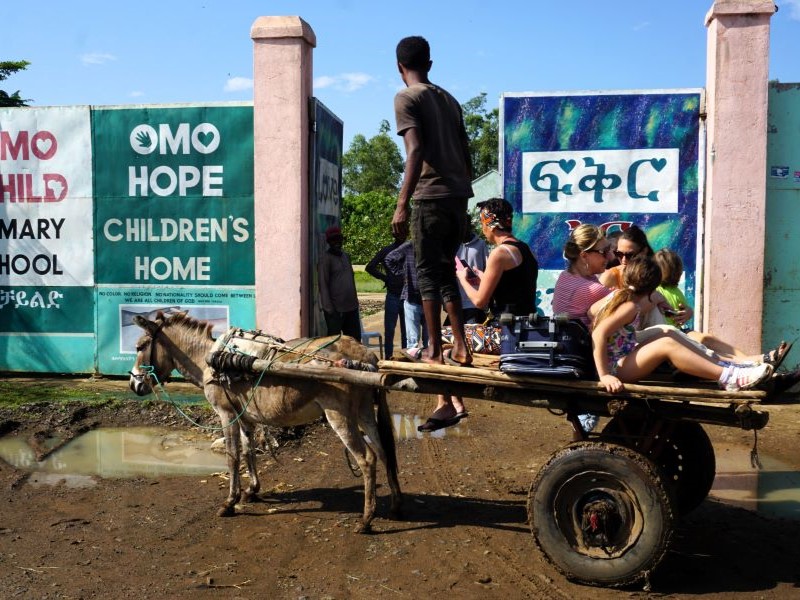
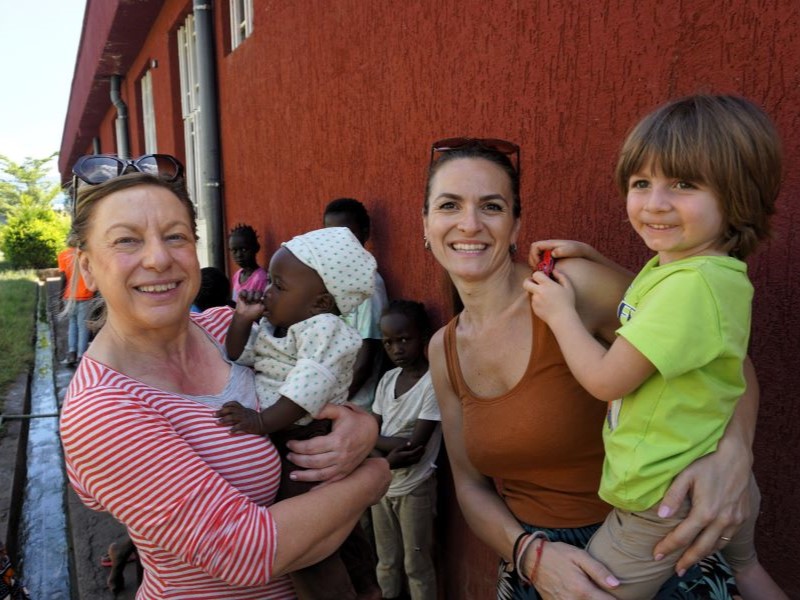
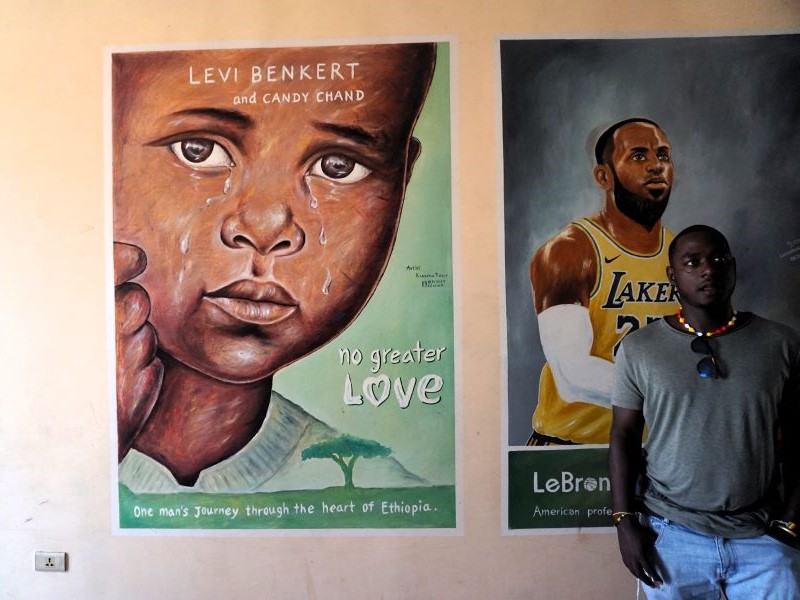
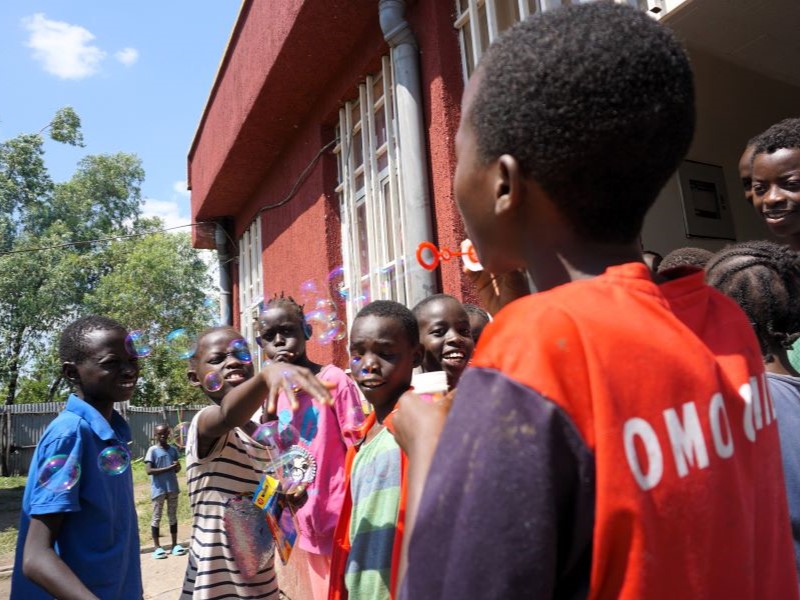
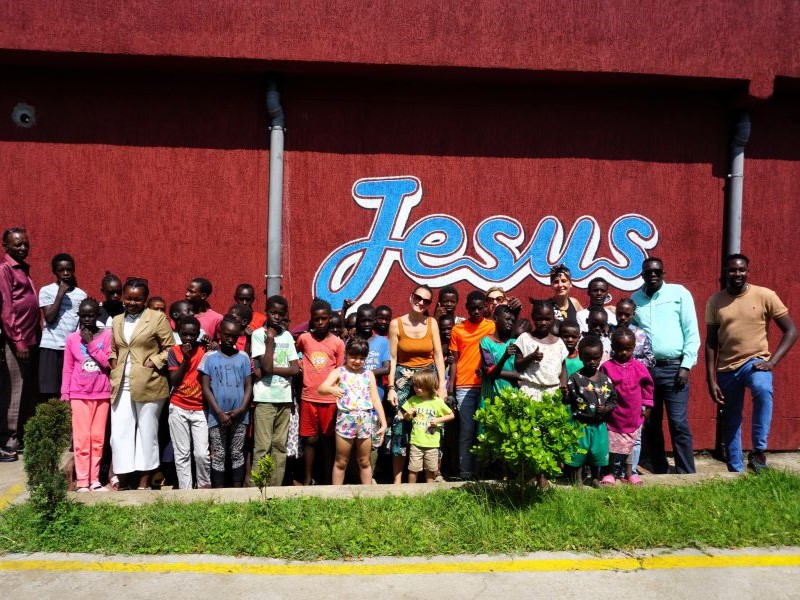
Here we go again: destination Turmi.
Along the way we meet some boys from the Banna tribe. It's the first time, after the trip to Papua New Guinea, which enchants me at every meeting.
The Banna are dedicated to agriculture but also hunt. They are similar to Hamer although they are distinguished by small details (color of the ornamental beads). The boys we met were balancing on long stilts, called “waga”, very picturesque.
Here we are in Turmi, the thermometer on my watch reads 40°C, it's ridiculously hot, we will stay for two nights at the spartan Emerald Lodge.
Here we are in the land of the Hamer and we are very excited when we often meet some women of the tribe along the way, with typical ocher hair and always heavy weights on their backs...
Suddenly we notice in a large clearing a huge number of Hamers around a truck (editor's note from the Government) which was distributing bags of corn and rice to them... help from the Government to this tribe that lives in one of the most inaccessible areas of the Planet...
We immerse ourselves delicately among them and I almost struggled to take some photos so enchanted by that open-air documentary.
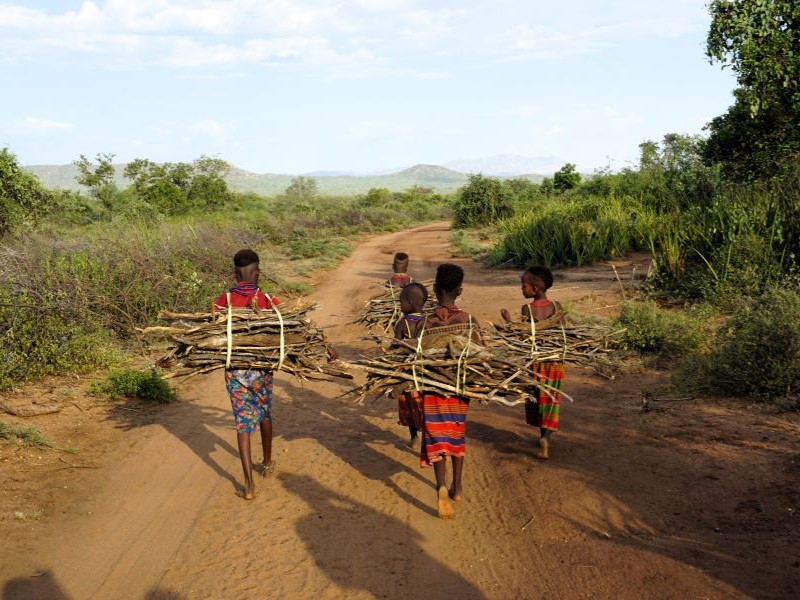
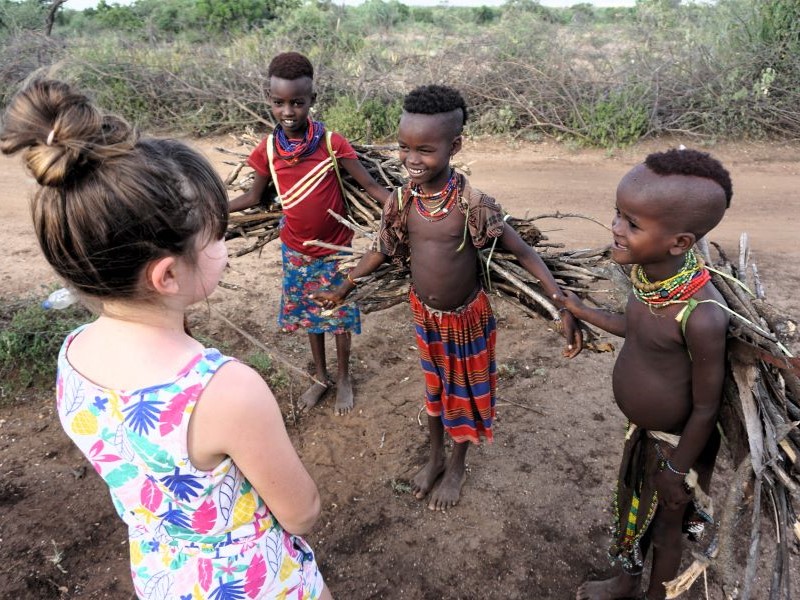
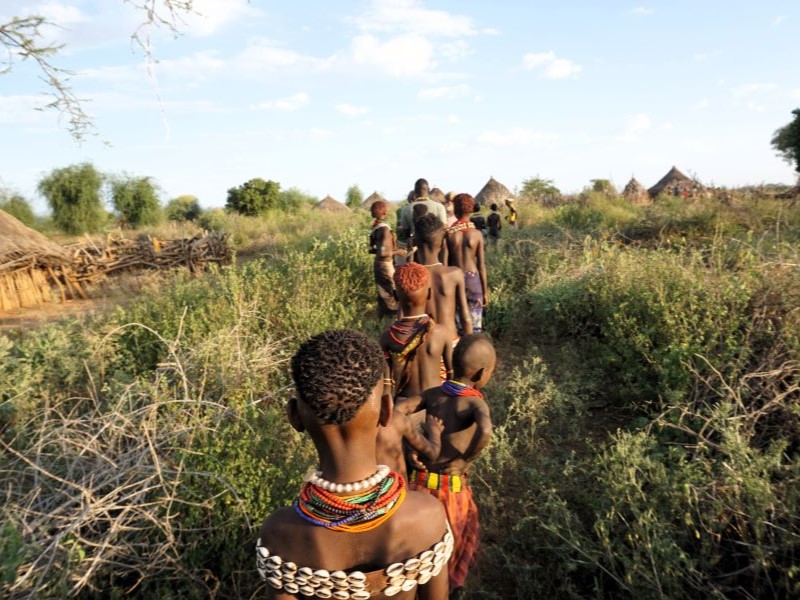
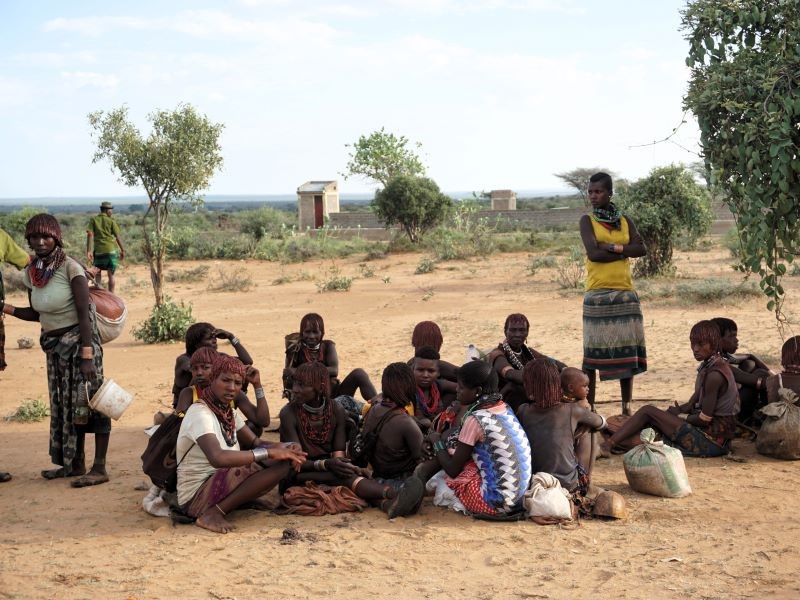
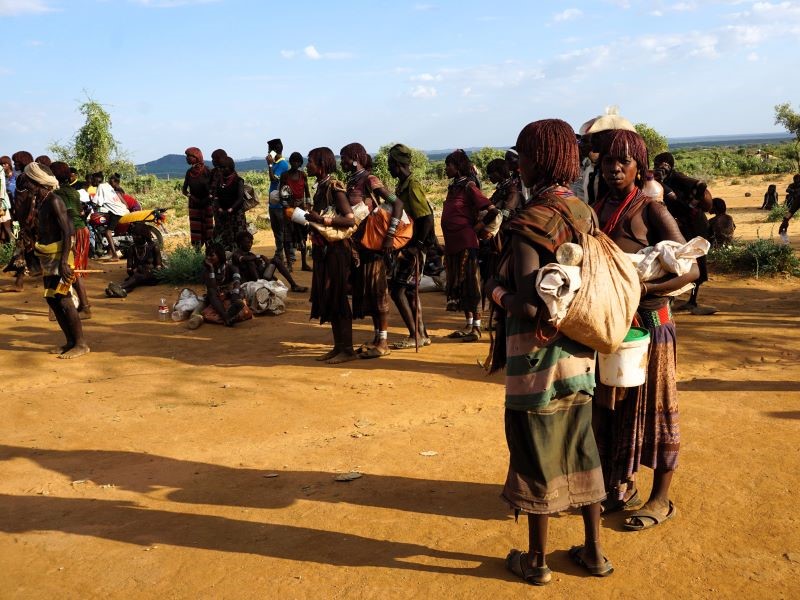
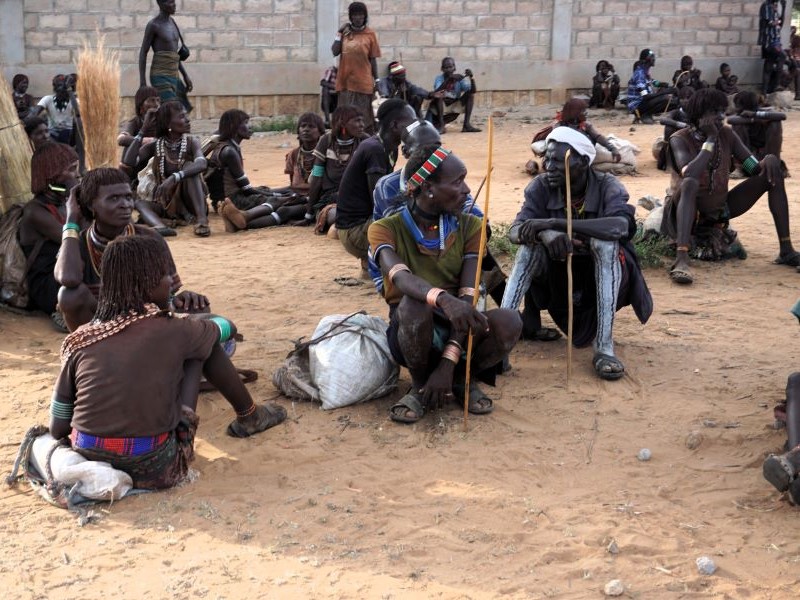
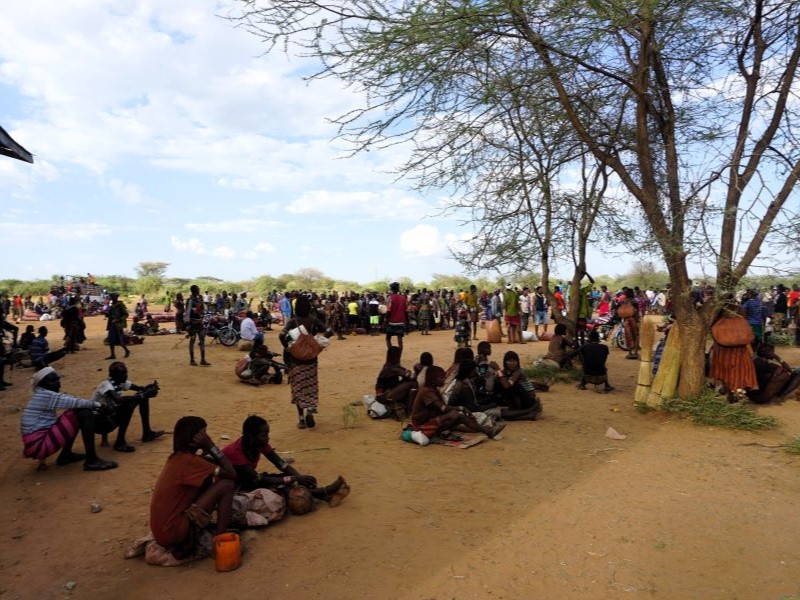
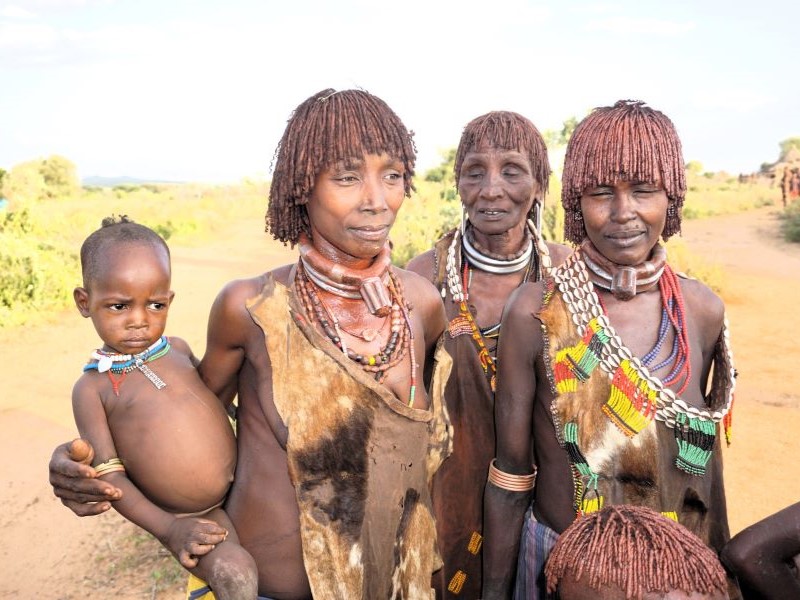
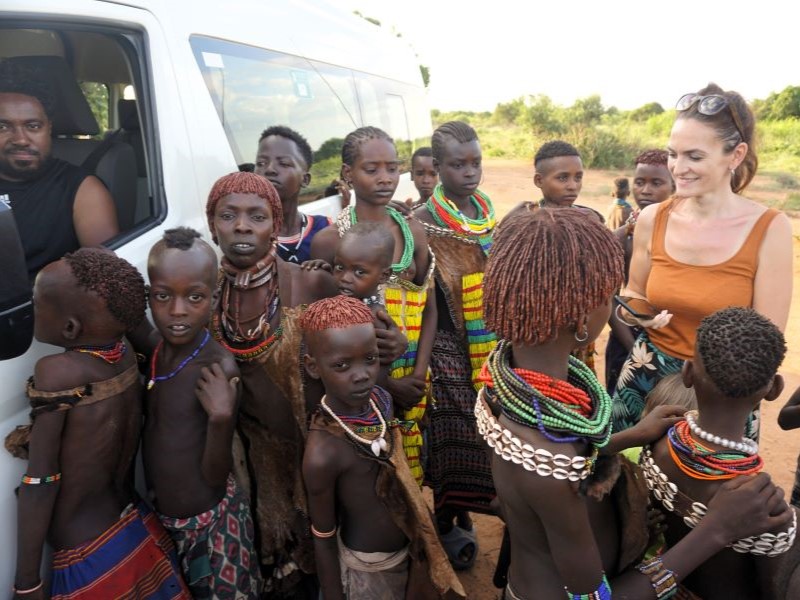
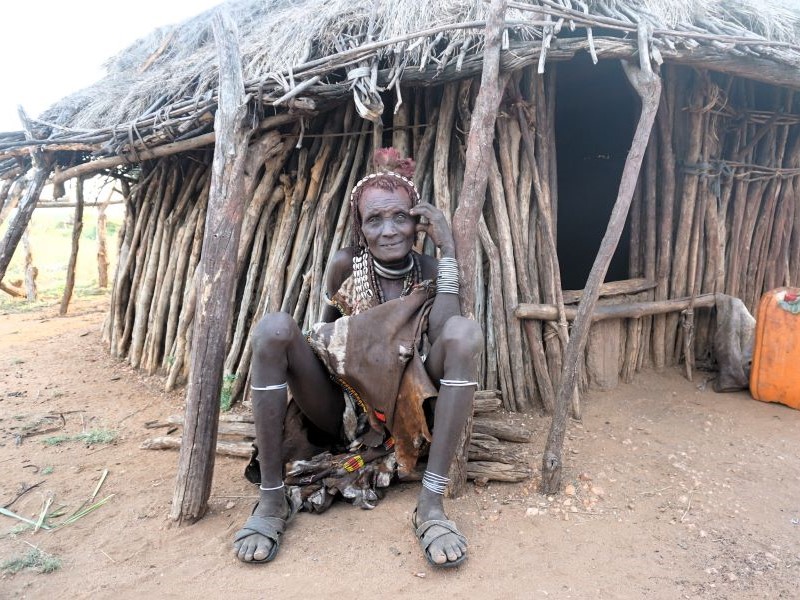
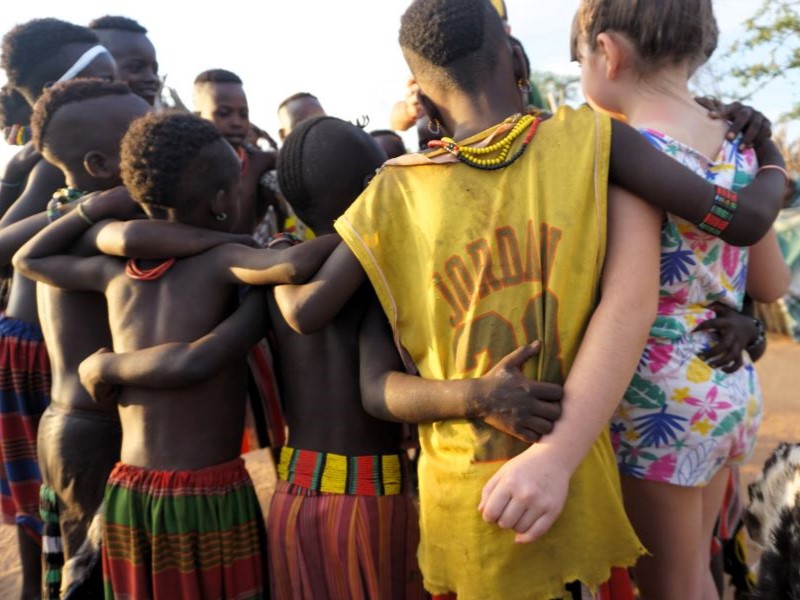
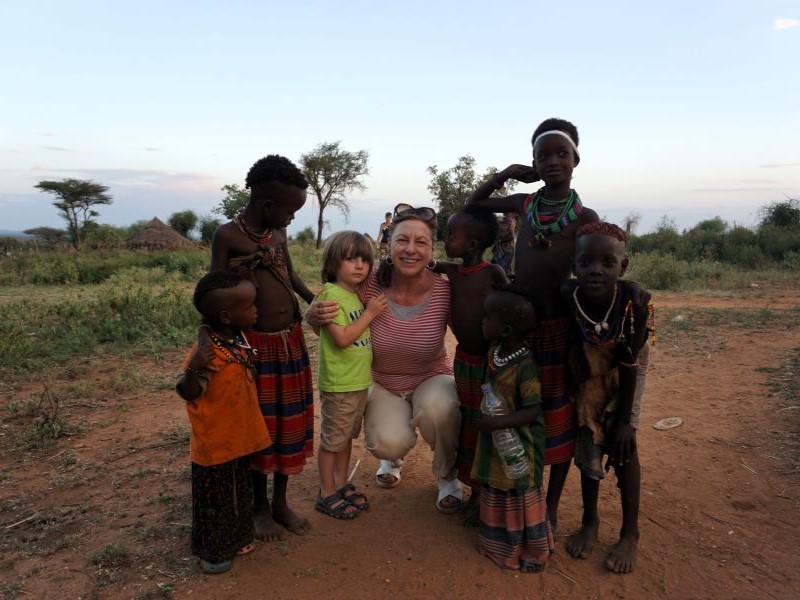
Not far away lies a small Hamer village... The Hamer are mostly farmers and breeders. They are famous for their original hairstyles. The women prepare a mixture of ocher, water and resin, apply it to their hair and then work one strand after another until they obtain many copper-colored braids called "goscha", a sign of prosperity and well-being.
The women wear beaded necklaces and iron arm bracelets. The “ensente” (narrow iron necklaces) worn by married or engaged women attest to the wealth and prestige of the husband or fiancé.
Spending a few hours immersed in their daily life was something immense, sometimes I was enchanted watching my daughter Nora interact, play, laugh with these children so far from her in total harmony, without barriers, without filters...
In an hour's journey from Turmi, we reach the wonderful Nyangatom tribe. Related to the Turkana of Kenya, are dedicated to agriculture, the cultivation of sorghum and corn and the herding of cows and goats. They make bees leave the hives with smoke to get honey.
Known as great warriors, in the past they were practically everyone's enemies, today they only have conflicts with the Dassanech in cases of cattle raids.
Nyangatom women are famous for their numerous necklaces and crowns on their heads often embellished with watch straps, used sim cards, pieces of colored plastic.
They have a hole under the lower lip from which an ivory horn often emerges for men and a copper one for women but also plastic straws, cigarette butts...
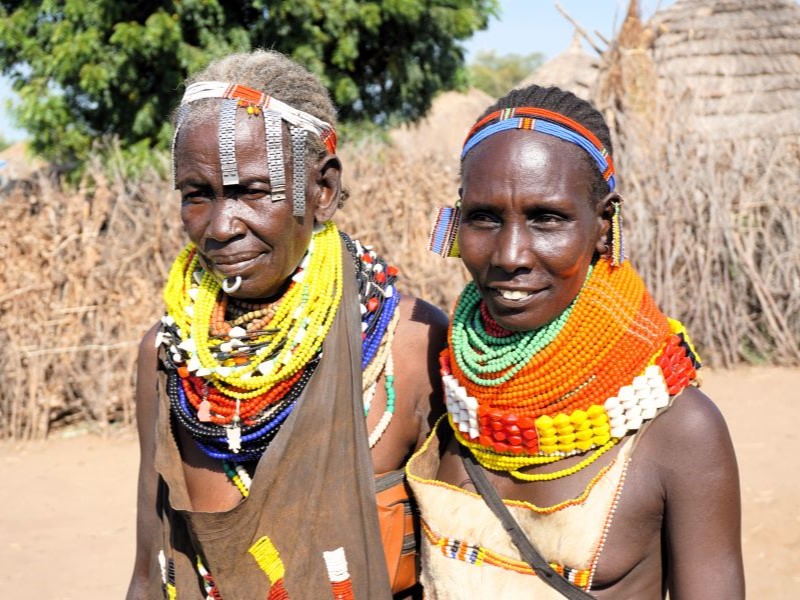
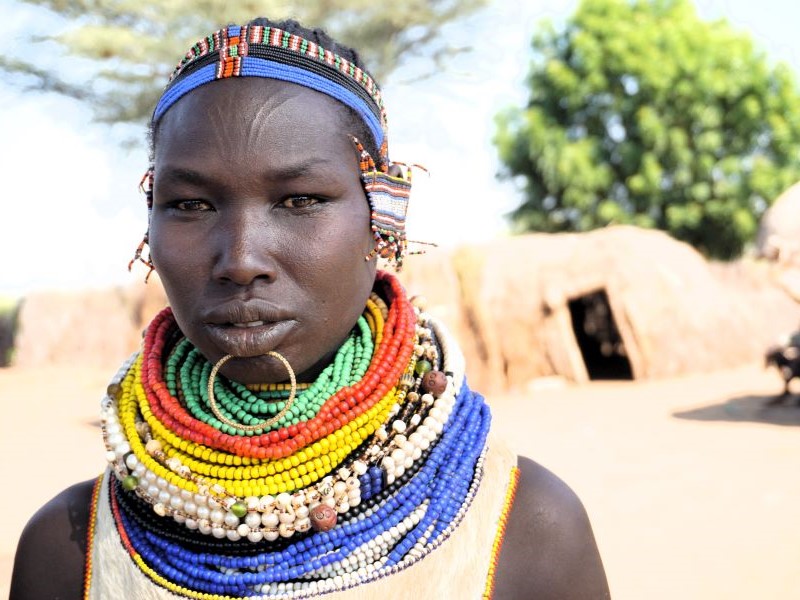
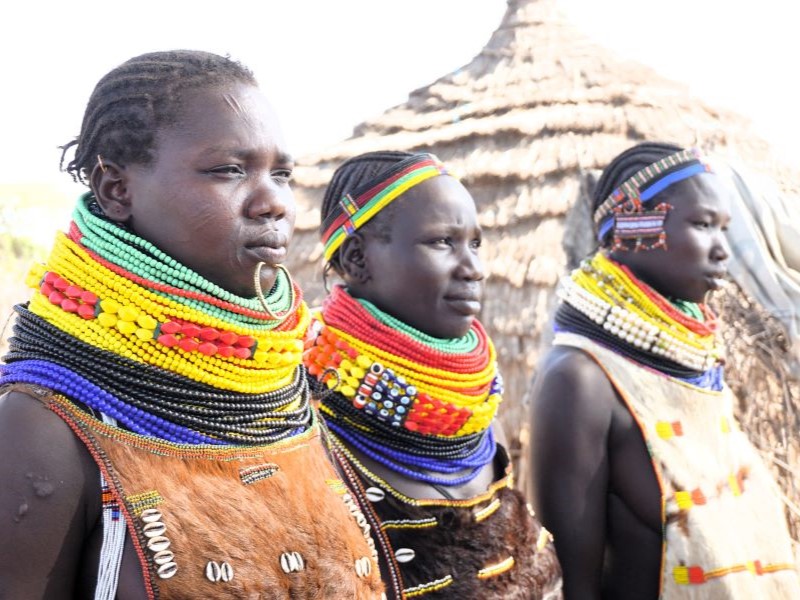
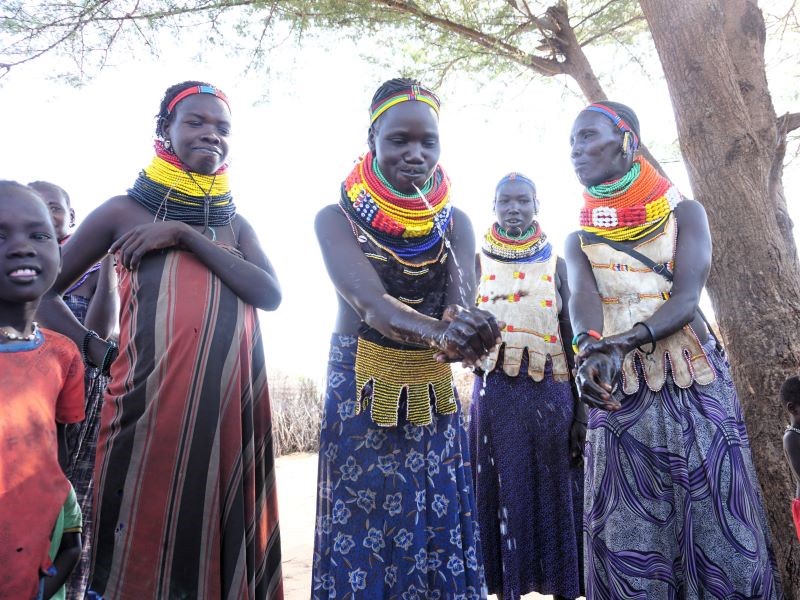
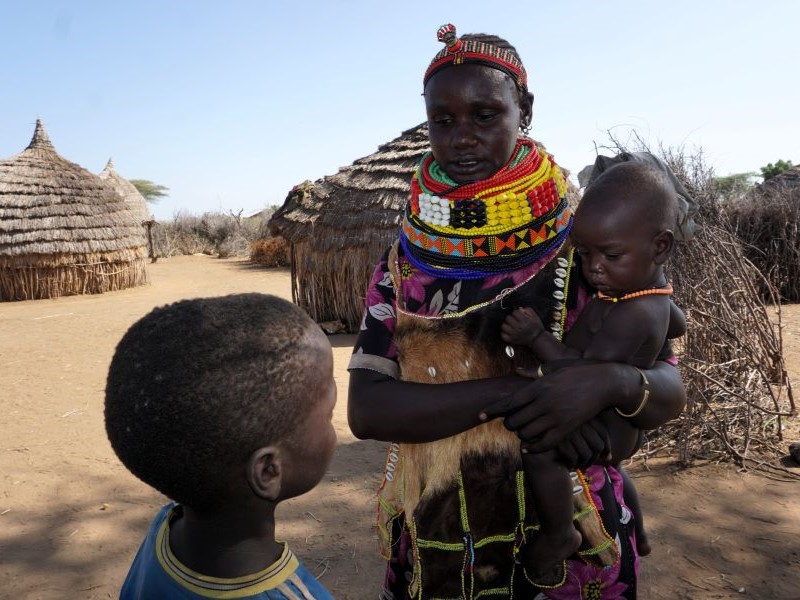
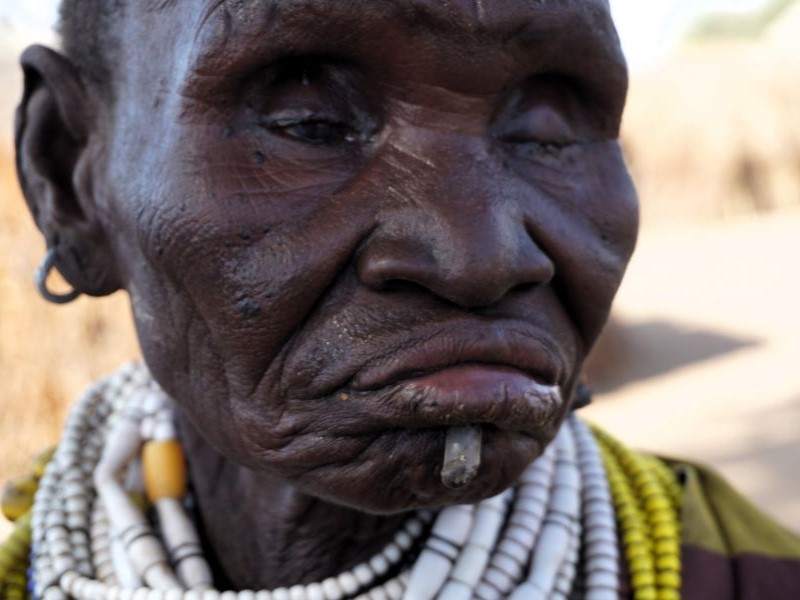
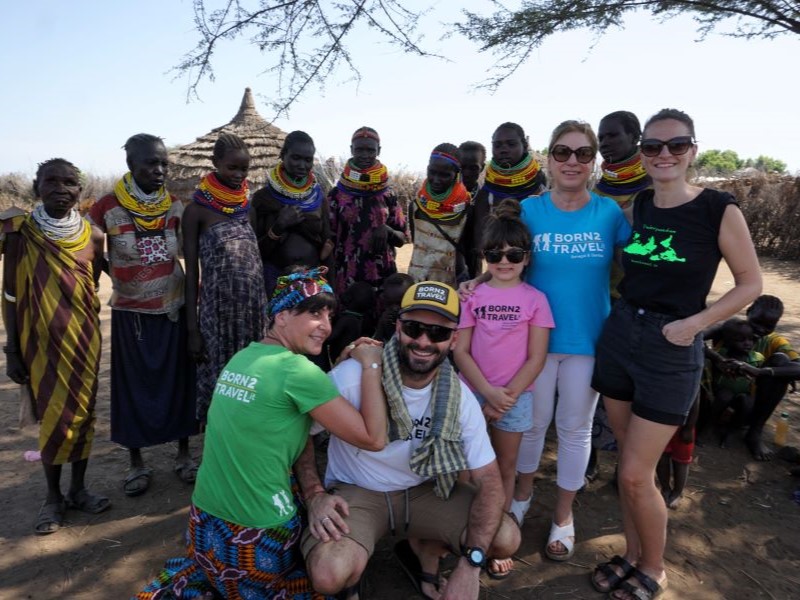
Not far away and with a unique view of the Omo River we reach the Karo tribe in Korcho.
The Karo are one of the ethnic groups in the Omo Valley at greatest risk of extinction (with a population of around 3000 people).
Once great shepherds but much of their livestock has been decimated by epidemics and many have become farmers of corn and sorghum.
They are considered masters of body painting using white and colored chalk to create bold decorations.
The most impressive moment of the day occurs in the afternoon when, by van, we reach the village of Dimaka, buzzing with the weekly market; Hamer women stroll through the wooden stalls, some drinking mugs of “parsi” (a local beer), selling ocher powder, tobacco or broken shells of used coffee as herbal tea…
On board four motorbikes we immerse ourselves in cosmic nothingness, every now and then we meet some Hamer women along the edge of the dusty road, always loaded to capacity and headed who knows where...
After 30 minutes of off road, we finally reach some huts... we meet a boy, 19 years old, completely naked: today is his ceremony, the infamous "bull leap".
The ceremony lasts several hours and we followed it all, admiring this world so far from us...
The women with bare breasts, colored necklaces, backs uncovered to show the wounds of previous rites, bells on their ankles, hair dripping a sandy red liquid from the sweat: they dance, sing, tap their feet on the ground, every now and then they stop to drink Parsi mugs…
After a few hours the bloodiest part arrives: the men arrive brandishing thin wooden whips and begin, following precise rituals, to give harsh lashes on the women's backs who, in the meantime, incite them to continue harder and harder! With each lash the flesh of my back opened up and bled… we watched in silence and horror, trying not to judge…
The rites follow one another and it is difficult to try to understand them. Finally, just after sunset, 10 bulls are gathered, some very agitated, placed next to each other while they kicked wildly, gored each other, bellowed...
It is all ready! Some hold the bulls still with the bridles protruding from their mouths, others pulling their tails tightly... there is excitement, everyone holds their breath... anxiety skyrocketing like at the start of the Palio in Siena.
The boy, known as the "jumper", is very tense, he takes courage and begins his run... he climbs onto the first bull and from there, naked, runs on the backs of these animals 8 times... the women dance and sing louder and louder almost in a trance…. He did it! He passed the test! From a boy he has become a man and is ready to find a wife!
It's almost dark, on the motorbike, we return to the village of Dimaka and then by van to Turmi, we're cooked!
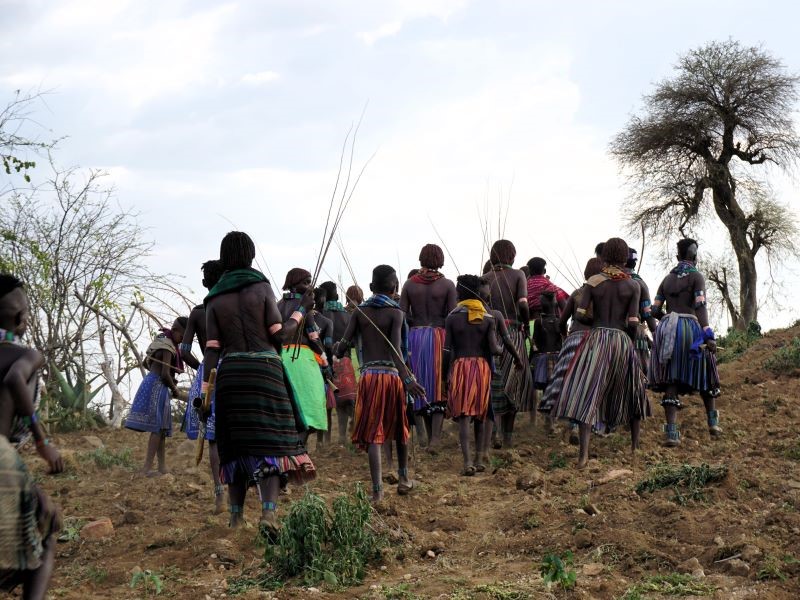
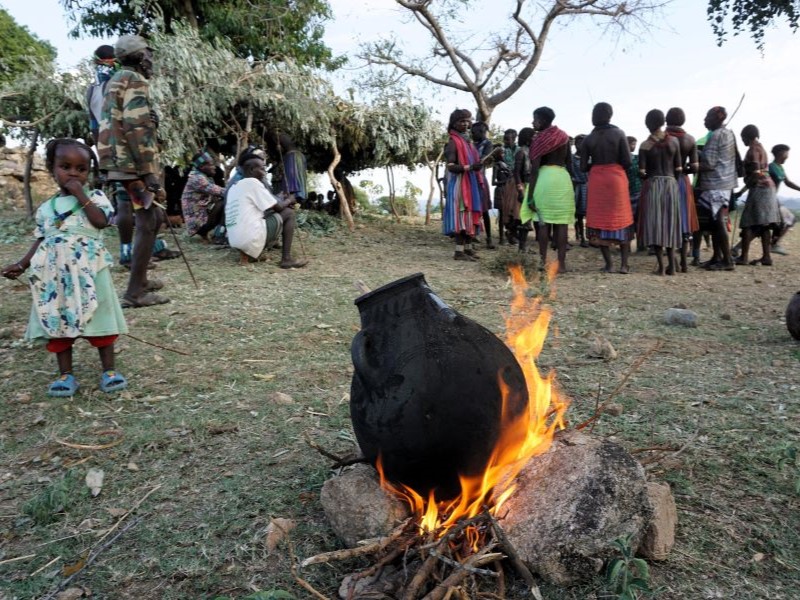
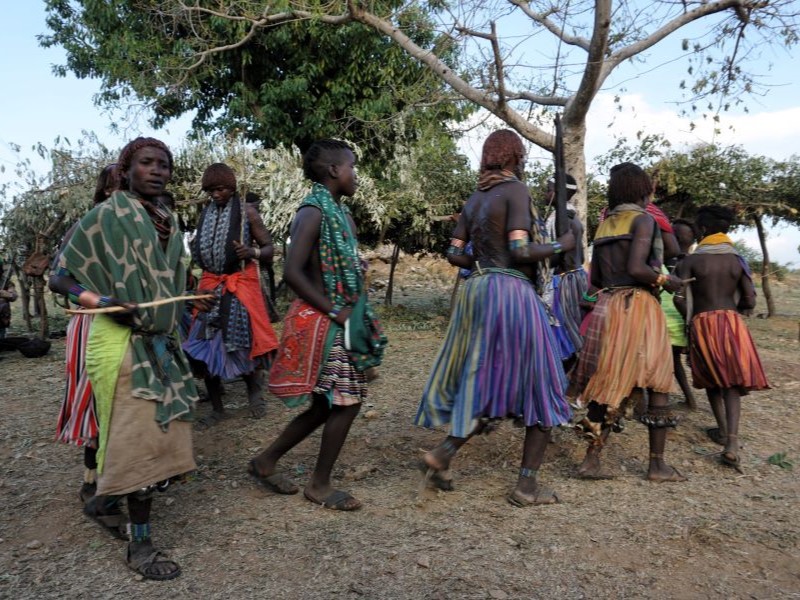
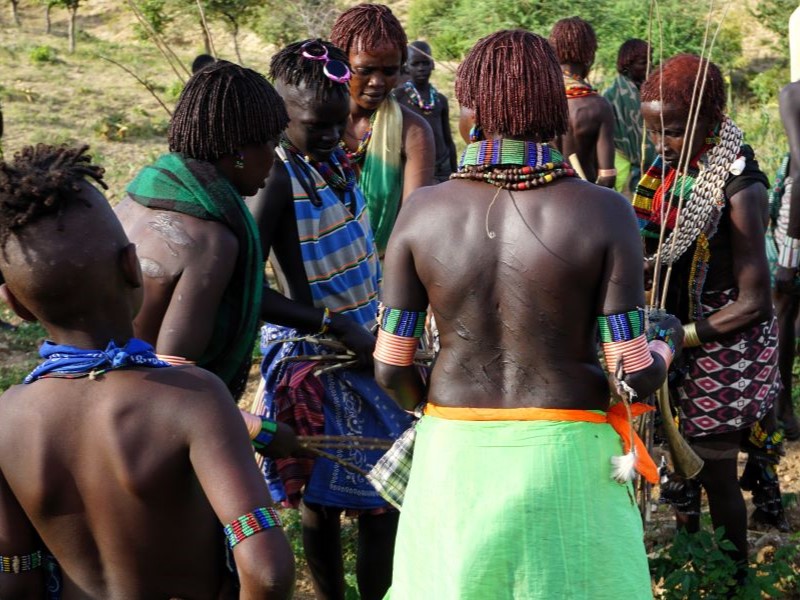
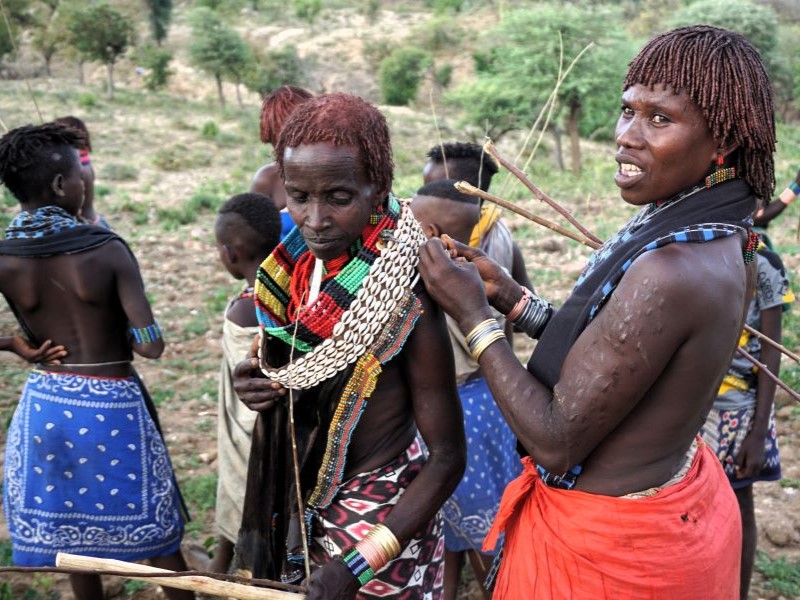
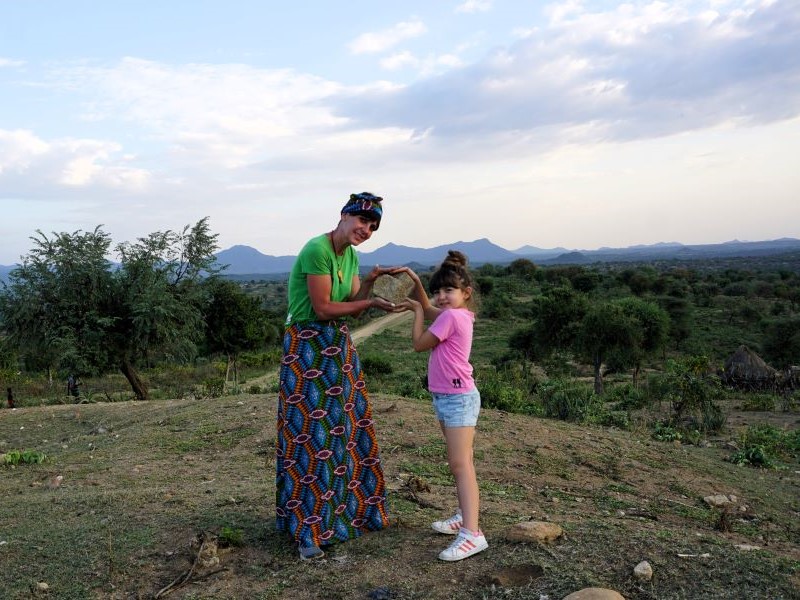
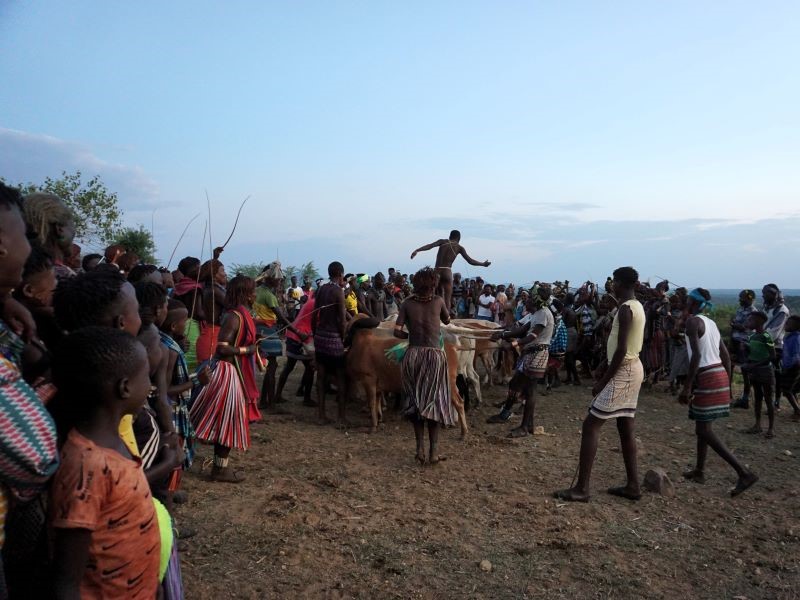
Today we are going south, close to the border with Kenya and South Sudan!
On board two canoes we sail along the Omo River to reach a small camp with sheet metal huts; it's scorching hot, it's almost 45°C, as we approach what looked like a refugee camp, they are the Dassanech, they live on the banks of the Omo river, between Omorate and Lake Turkana. Originally shepherds, today they also cultivate corn, sorghum and tobacco although cattle breeding remains their main livelihood activity.
Together with the Arbore tribe they are one of the poorest peoples in the valley. Dassanech women make beads from plastic waste like the Nyangatom, their enemies, but they wear fewer necklaces.
The visit to the camp is very engaging, we see these women covered only by a small skirt, building their own huts or looking after the little ones while the men are out with the animals, they have nothing and the living conditions are at the limit!
We set off again in the afternoon, heading north... after many hours on the dirt road we stop at another field, another desolate area, far from everything and without the possibility of help from Nature. It is a village of the Arbore tribe: they too are shepherds with a life that essentially depends on their cows and from which they derive all their sustenance. A very poor, curious and color-loving tribe, especially thanks to the necklaces of colored beads with which they decorate their bodies!
The men have old Kalashnikovs in their hands, they say they use them to protect livestock from wild beasts.
In the evening we arrive in Konso, we will stay at the cute Kanta Lodge, one of the best lodges and restaurants of the entire trip.
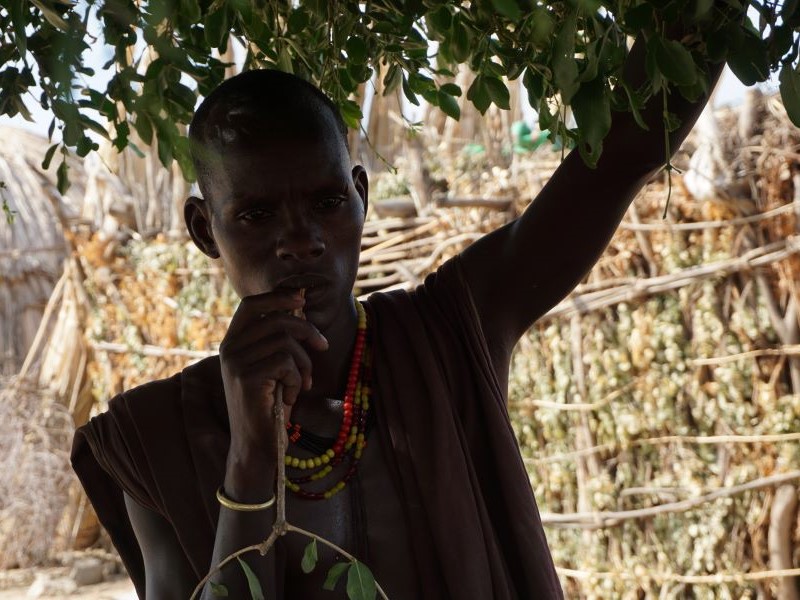
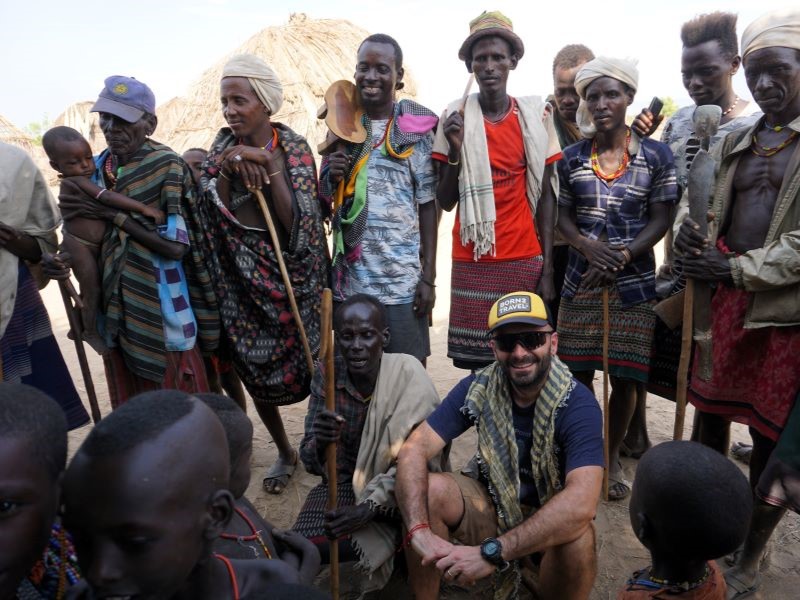
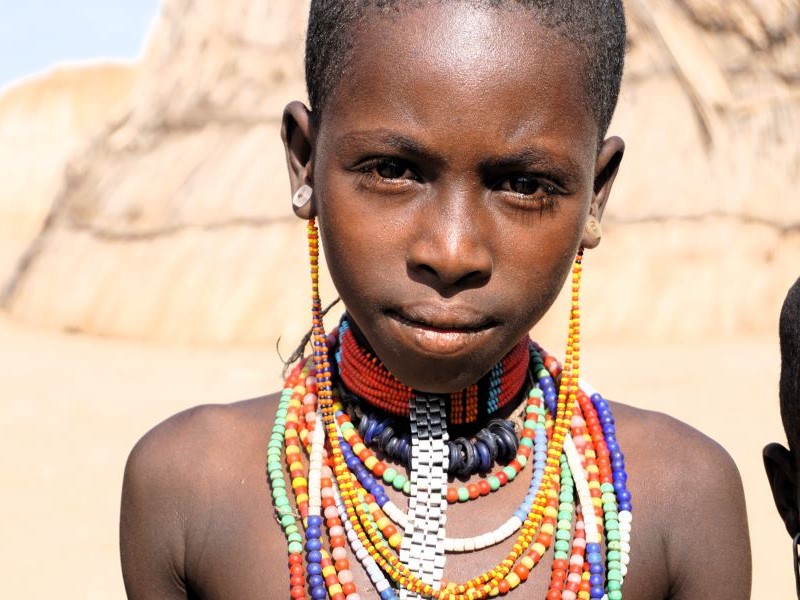
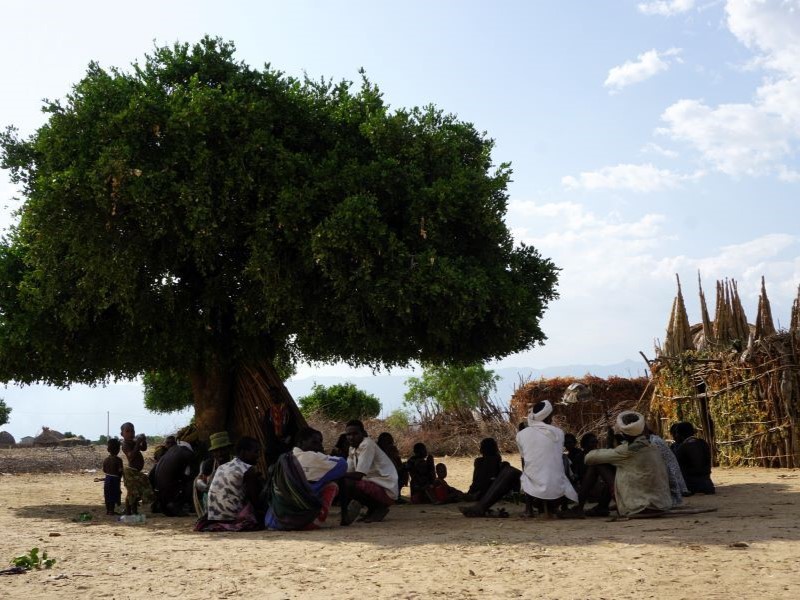
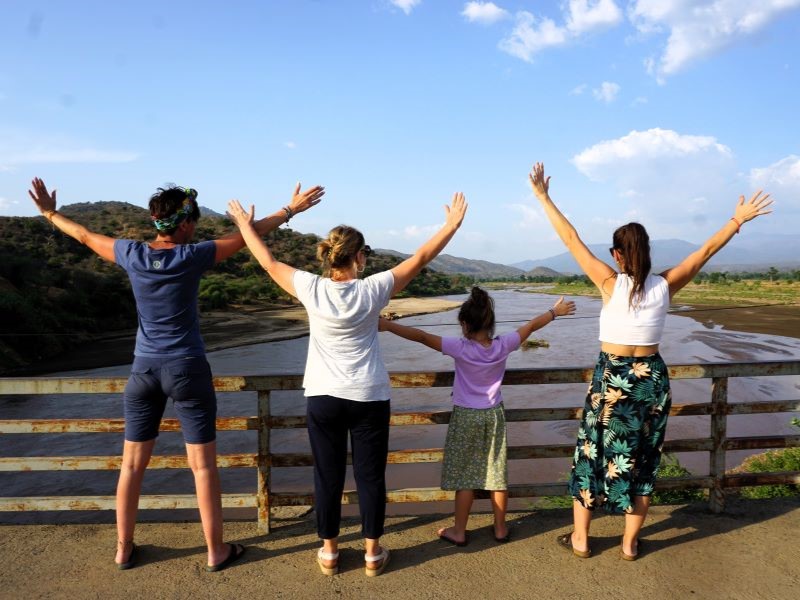
We wake up very early this morning because two long days of travel await us.
Fourth consecutive day without electricity… Don't forget to charge cameras and cell phones from the van!
After a couple of hours on the dirt road we reach the shores of Lake Chamo. On board a light boat we set off to discover this precious body of water. These waters are populated by some of the most dangerous crocodiles because there are few fish in the lake and therefore they often become aggressive towards humans.
We saw many birds flying free, even the majestic fish eagles. But be careful because there are also hippos... we met one with her puppy... we stayed away because the mothers, in these cases, can be extremely aggressive.
Excellent lunch at the faithful Haile resort with a superb view of Lake Chamo in Arba Minch.
Another four hours of van crossing a landscape that always changes and continuously gives us such intense and sometimes crude images of daily life until we reach the chaotic Hawassa.
Hawassa seems like a holiday resort given the many Western style hotels, bars and nightclubs.
We visit the picturesque fish market early in the morning. The fishermen leave at four in the morning, returning at seven with full nets, this lake is particularly generous...
One group puts the nets in order, others divide the catch according to type and size, others sell it, still others cook it for the customers who crowd in... they are divided into associations and it is nice to see how they spend their local life...
Next door is Gudumale Park, a small city park populated by very disciplined vervet monkeys and colobus monkeys that wander around peacefully jumping from one branch to another without disturbing visitors too much but always ready to approach if someone has a fruit or nut.
Along the way we stop curiously to visit Sciasciamanna: the small oasis of peace that Rastafarians mostly coming from the Caribbean and the United States call home. This is certainly no surprise to reggae music lovers who know well that Ethiopia is considered the promised land, the land of Zion, waiting to welcome African descendants repatriated from all over the world.
Long and final transfer to the capital Addis Ababa. Tonight we will spend the last evening with Bereket at the beautiful typical restaurant Yod Abyssinia with traditional dishes and dancers who entertain diners with Ethiopian dances!
This wonderful journey to discover the Omo Valley is coming to an end and I sincerely thank Bereket of Omo Valley Origin Tours for the professionalism with which he handled all the daily problems of a traveling trip and I bid him farewell with the promise of returning to visit the north of the country soon!
Error: No feed found.
Please go to the Instagram Feed settings page to create a feed.
2 Responses
Que descrição tão sentida que nos faz também viajar, quase que senti o cheiro de tudo, os sons e as danças tradicionais fabulosas. A cultura tão própria de uma populacao quase oculta do mundo.
Essas lindas, mulheres adornadas na beleza dos seus enfeites coloridos
Essas crianças tão lindas e com ar tão feliz ,mesmo sofrendo na pele a carência de uma alimentação mais equilibrada e rica. Que lição.
Que maravilha poder viajar no tempo que a vida permite, beneficiando-vos vivências incrivelmente espantosas de humildade e amor .
Parabéns por diferentes aprendizagens e que tão gigantesca foram colhidas nas lições de simplicidade,
aliando a humildade de um povo bom. A construção da personalidade e carácter são como as mantas de retalho…que bom poderem proporcionar mais este pedaço da vida tambem às vossas crianças.
Ola querida Ofelinha, thanks for the nice words and thanks because you have managed to catch what we wanted to express with our reportage. This trip has been so intense and we have loved every single day spent over there. Obrigado